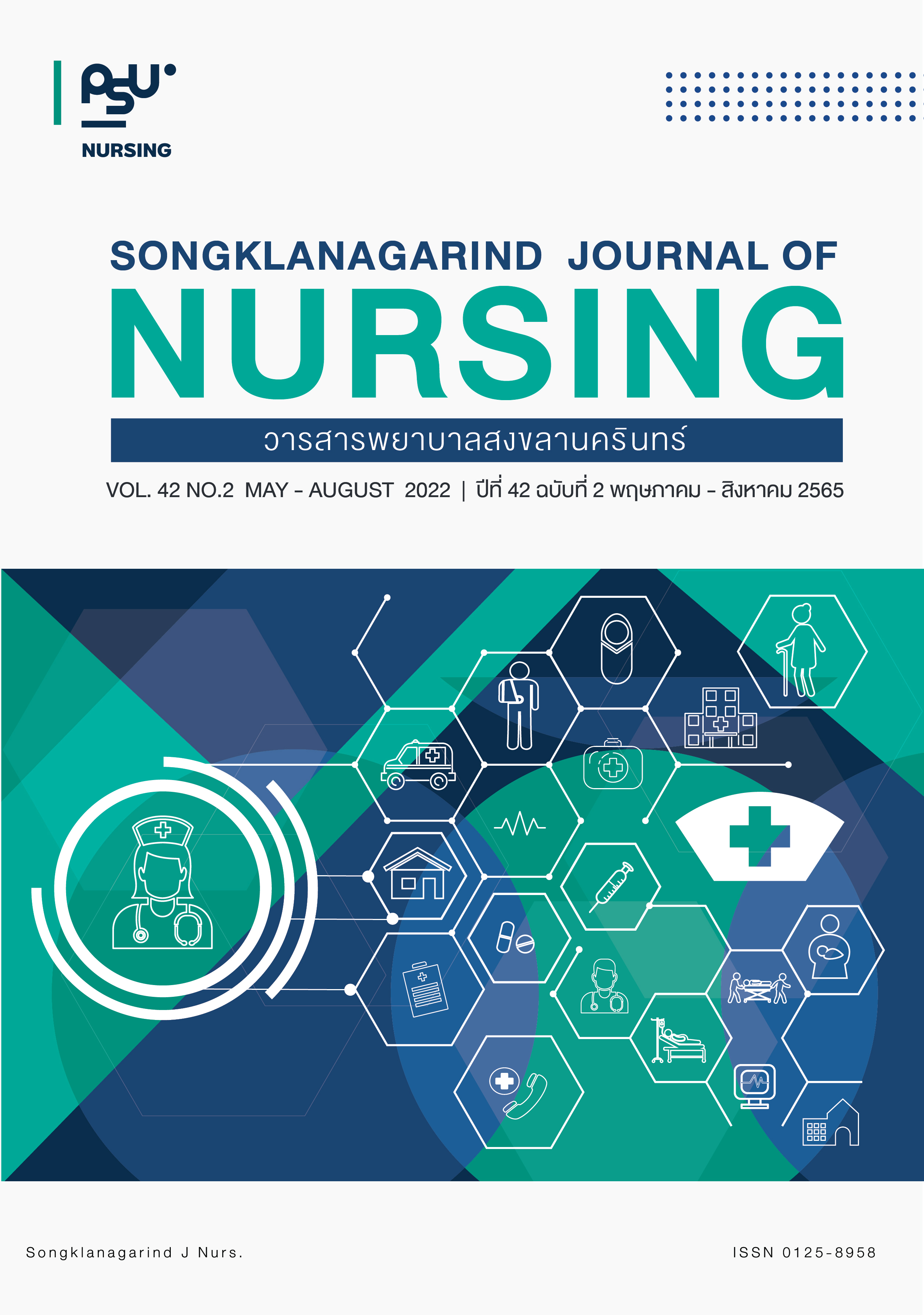Factors Related to Caring Behaviors for Patients at the End-of-Life among Fourth-Year Nursing Students, Prince of Songkla University
Main Article Content
Abstract
Objectives: This research aimed to examine the level of caring behaviors for patients at the end of life and its related factors among fourth-year nursing students who were studying in the last semester at the Faculty of Nursing, Prince of Songkla University. Methods: The data were collected from two hundred and seven students using questionnaires. The demographic data and the level of caring behaviors for patients at the end of life were analyzed using descriptive statistics. The relationship between caring behaviors and its factors including knowledge in end-of-life care, attitudes toward death and dying, self-directed learning readiness, and preparedness in caring for patients at the end of life were analyzed using the Pearson correlation coefficient. Results: The results showed that overall caring behaviors for patients at the end of life were at a moderate level (M = 112.96, SD = 16.16). Self-directed learning readiness and preparedness in caring for patients at the end-of-life were positively correlated with participants’ caring behaviors (r = .28, p < .001, r = .31, p < .001), respectively. Conclusion: Nursing institution plays an important role in supporting nursing students’ self-directed learning readiness and preparing them to become caring nurses embedded caring behaviors for patients at the end of life.
Article Details

This work is licensed under a Creative Commons Attribution-NonCommercial-NoDerivatives 4.0 International License.
References
Australian Institute of Health and Welfare 2016. End-oflife-care [Internet]. Canberra: AIHW; 2016 [cited 2021 Nov 25]. Available from: https://www.aihw.gov.au/getmedia/68ed1246-886e-43ff-af35-d52db9a9600c/ah16-6-18-endof-life-care.pdf.aspx.
World palliative care alliance. Global atlas of palliative care at the end of life [Internet]. Geneva: World Palliative care alliance; 2014 [cited 2021 Nov 25]. Available from: http://www.who.int/nmh/Global_Atlas_of_Palliative_Care.pdf
Clark D, Baur N, Clelland D, et al. Mapping levels of palliative care development in 198 countries: The situation in 2017. J Pain Symptom Manage. 2020; 59(4): 794-807. doi: 10.1016/j.jpainsymman.2019.11.009.
Nilmanat K. Palliative care in Thailand: Development and challenges. Can Oncol Nurs J. 2016; 26(3): 262-4.
Krongyuth P, Campbell CL, Silpasuwan P. Palliative care in Thailand. Int J Palliat Care Nurs. 2014; 20(12): 600-7. doi: 10.12968/ijpn.2014.20.12.600.
Roach MS. Caring, the human mode of being: A blueprint for the health professionals. 2 nd ed. Canada: CHA Press; 2002.
Azizi-Fini I, Mousavi M-S, Mazroui-Sabdani A, et al. Correlation between nurses’ caring behaviors and patients’ satisfaction. Nurs Midwifery Stud. 2012; 30(1): 36-40. doi: 10.5812/nms.790.
Bukuku DD, Chontawan R, Akkadechanunt T. Nurse caring behaviors and patient satisfaction in a tertiary care hospital, The United Republic of Tanzania. Nurs J. 2018; 45(4): 217-28.
Calong KAC, Soriano GP. Caring behavior and patient satisfaction: Merging for satisfaction. 2018; 11(2): 697-703.
Xia L, Kongsuwan W. Factors relating to nurses’ endof-life care. J Biosci Med. 2020; 8(6): 189-200. doi: 10.4236/jbm.2020.86018.
Akarathanarak T, Kongsuwan W, Matchim Y. Relationship between preparedness and caring behavior for patients at the end of life among novice nurses. J Public Health Nurs. 2017; 31(1): 160-74. Thai.
Matchim Y, Thongthawee B. Nursing students’ and novice nurses’ caring behaviors toward care for end-of-life patients and related factors. Songklanagarind J Nurs. 2019; 39(2): 73-86. Thai.
Curtis K. 21st century challenges faced by nursing faculty in educating for compassionate practice: Embodied interpretation of phenomenological data. Nurse Educ Today. 2013; 33(7): 746-50. doi: 10.1016/j.nedt.2013.05.007.
Aupia A, Lee TT, Liu CY, et al. Caring behavior perceived by nurses, patients and nursing students in Indonesia. J Prof Nurs. 2018; 34(4): 314-9. doi: 10.1016/j.profnurs.2017.11.013.
Labrague LJ. Caring competencies of baccalaureate nursing students of samar state university. J Nurs Educ Pract. 2012; 2(4): 105-13. doi: 10.5430/jnep.v2n4p105.
Thongthawee B, Matchim Y, Kaewsriwong S. Caring behaviors in providing care for end-of-life patients of nursing students and novice nurses, Thammasat University. Songklanagarind J Nurs. 2018; 38(4): 35-48. Thai.
Yamane T. Statistics: An introductory analysis. 2 nd ed. New York: Harper and Row; 1967.
Nulty DD. The adequacy of response rates to online and paper surveys: What can be done?. Assess. Eval. High. Educ. 2008; 33(3): 301-14. doi: 10.1080/02602930701293231.
Prompahakul C, Nilmanat K, Kongsuwan W. Nurses’ caring behaviors for dying patients in southern Thailand. Nurse Media. 2011; 1(2): 147-58. doi: 10.14710/nmjn.v1i2.972.
Ross MM, McDonald B, McGuinness J. The palliative care quiz for nursing (PCQN): The development of an instrument to measure nurses’ knowledge of palliative care. J Adv Nurs. 1996; 23(1): 126-37. doi: 10.1111/j.1365-2648.1996.tb03106.x.
Satsin T, Matchim Y, Thongthawee B. Emergency nurses’ competency in the provision of palliative care and related factors. Songklanagarind J Nurs. 2017; 37(Suppl): 41-50. Thai.
Srisuwan N, Matchim Y, Nilmanat K. Nurses’ competency in communication with patients at the end of life and their families and related factors. Songklanagarind J Nurs. 2014; 34(3): 109-24. Thai.
Abelsson A, Willman A. Caring for patients in the end-oflife from the perspective of undergraduate nursing students. Nurs. Forum. 2020; 55(3): 433-8. doi: 10.1111/nuf.12448.
Yang G-F, Jiang XY. Self-directed learning readiness and nursing competency among undergraduate nursing students in Fujian province of China. Int J Nurs Sci. 2014; 1(3): 255-9. doi: 10.1016/j.ijnss.2014.05.021.
Henoch I, Melin-Johansson C, Bergh I, et al. Undergraduate nursing students’ attitudes and preparedness toward caring for dying persons - a longitudinal study. Nurse Educ Pract. 2017; 26: 12-20. doi: 10.1016/j.nepr.2017.06.007.
Jafari M, Rafiei H, Nassehi A, et al. Caring for dying patients: Attitude of nursing students and effects of education. Indian J Palliat Care. 2015; 21(2): 192-7. doi: 10.4103/0973-1075.156497.


